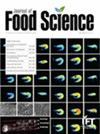Modeling and chewing parameters calibration of Euryale ferox based on discrete element method
Abstract
Euryale ferox was chosen for this study to examine its mechanical properties during chewing. Experiments and the discrete element method were used to conduct the study. Initially, the intrinsic and contact parameters of E. ferox were established through physical tests. The maximum compressive force of breakage and chewing mechanical properties (hardness, springiness, and chewiness) were measured using a texture profile analyzer (TPA). A Hertz–Mindlin with bonding model of the E. ferox was constructed. Optimal values for significant factors, including the normal stiffness per unit area, shear stiffness per unit area, and bonding radius, were obtained through single-factor, Plackett–Burman, steepest ascent, and Box–Behnken response surface tests, with the maximum compressive force as the index. Under optimal parameter combination conditions, the relative error between the simulated and experimental values of the maximum compressive force was 0.79%, and the relative errors between the simulated and TPA test values of all indicators were less than 5.65%. This study provides a valuable reference for simulating the textural characteristics of agricultural products.

 求助内容:
求助内容: 应助结果提醒方式:
应助结果提醒方式:


